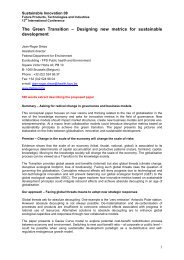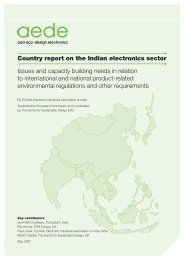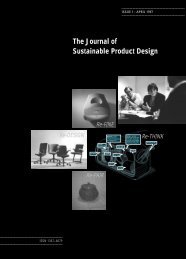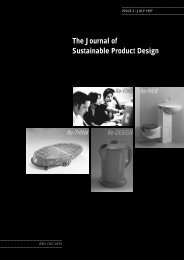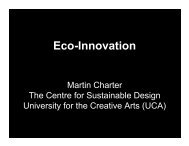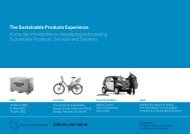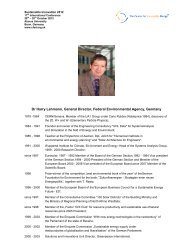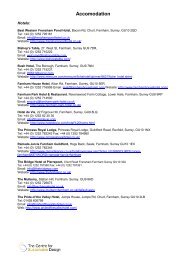acrobat JSPD 8 - The Centre for Sustainable Design
acrobat JSPD 8 - The Centre for Sustainable Design
acrobat JSPD 8 - The Centre for Sustainable Design
You also want an ePaper? Increase the reach of your titles
YUMPU automatically turns print PDFs into web optimized ePapers that Google loves.
Product life spans<br />
As the proportion of people<br />
owning household goods such as<br />
refrigerators, washing machines<br />
and telephones began to rise<br />
towards saturation levels after<br />
the second world war, manufacturers<br />
feared the impact upon<br />
sales volumes. Many responded<br />
by reducing the design life of<br />
such products and increasing the<br />
frequency with which they<br />
updated models (OECD, 1982;<br />
Cooper, 1994b). As a debate<br />
ensued in journals such as the<br />
Harvard Business Review<br />
(Stewart, 1959), prominent critic<br />
Vance Packard popularised the<br />
term ‘planned obsolescence’<br />
(Packard, 1963).<br />
It was suggested that shorter<br />
product life cycles would benefit<br />
the economy. Typical was<br />
industrial designer J. Gordon<br />
Lipincott. Later critical of<br />
declining product quality, he<br />
once wrote:<br />
‘Any method that can motivate the<br />
flow of merchandise to new buyers<br />
will create jobs and work <strong>for</strong> industry,<br />
and hence national prosperity…<br />
Our custom of trading in our<br />
automobiles every year, of having<br />
a new refrigerator, vacuum cleaner<br />
or electric iron every three or four<br />
years is economically sound.’<br />
(Whiteley, 1993, p.16).<br />
George Nelson, another<br />
respected designer, said ‘what we<br />
need is more obsolescence, not<br />
less’ (Whiteley, 1993, p.15). Such<br />
people advocated the development<br />
of improved and more<br />
efficient products: ‘Freezing<br />
design would, in most cases,<br />
perpetuate our problems,’ wrote<br />
Harrison Grathwohl (Aaker and<br />
Day, 1978, p.345). <strong>Design</strong>ers<br />
expressing strong reservations<br />
about the trend, such as Victor<br />
Papanek (1984), represented a<br />
small minority.<br />
<strong>The</strong> situation has since changed.<br />
Many leading manufacturers now<br />
argue that longer product life<br />
spans should be encouraged in<br />
order to achieve progress<br />
towards sustainable development<br />
(Falkman, 1996). Managers<br />
are increasingly expected to<br />
integrate environmental considerations<br />
into product development<br />
(Environment Council,<br />
1997). It is recognised that such a<br />
strategy could offer manufacturers<br />
a new competitive edge<br />
(Cooper, 1994a). Few designers<br />
today would publicly defend<br />
planned obsolescence.<br />
In the past, it was feared that an<br />
economy in which products<br />
lasted longer would grow more<br />
slowly, with reduced manufacturing<br />
output and retailers suffering<br />
lower sales. However, these<br />
negative impacts could be offset<br />
by an increase in labour intensive<br />
after-sales work such as<br />
repair, reconditioning and<br />
upgrading. <strong>The</strong> ‘throwaway economy’<br />
would be trans<strong>for</strong>med into<br />
the ‘service economy’, with a net<br />
positive impact on employment.<br />
<strong>The</strong> economy would only suffer<br />
if domestic manufacturers proved<br />
unable to supply higher quality<br />
products designed <strong>for</strong> longer life<br />
spans.<br />
JANUARY 1999 · THE JOURNAL OF SUSTAINABLE PRODUCT DESIGN<br />
ANALYSIS<br />
In the past,<br />
it was feared<br />
that an<br />
economy in<br />
which products<br />
lasted longer<br />
would grow<br />
more slowly,<br />
with reduced<br />
manufacturing<br />
output and<br />
retailers<br />
suffering<br />
lower sales.<br />
11



